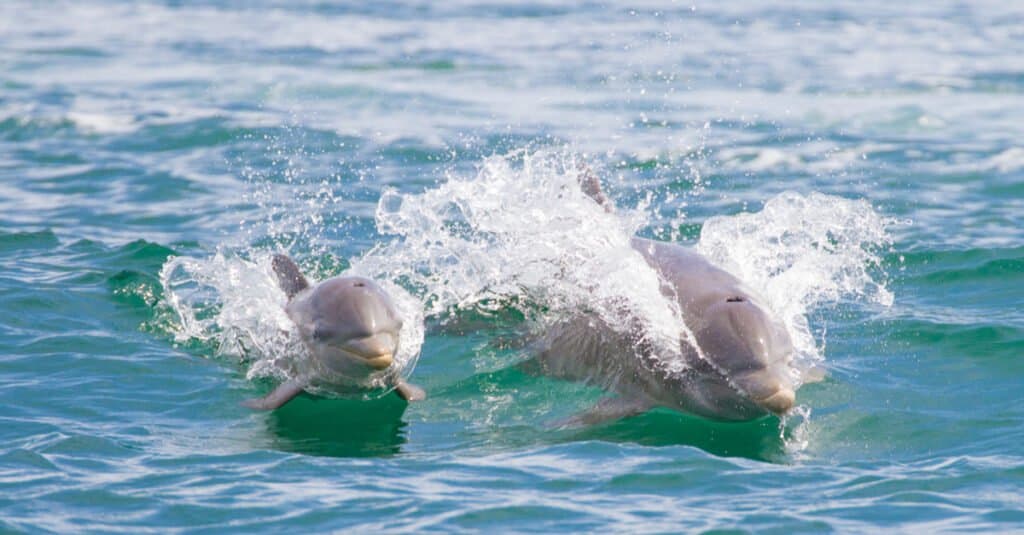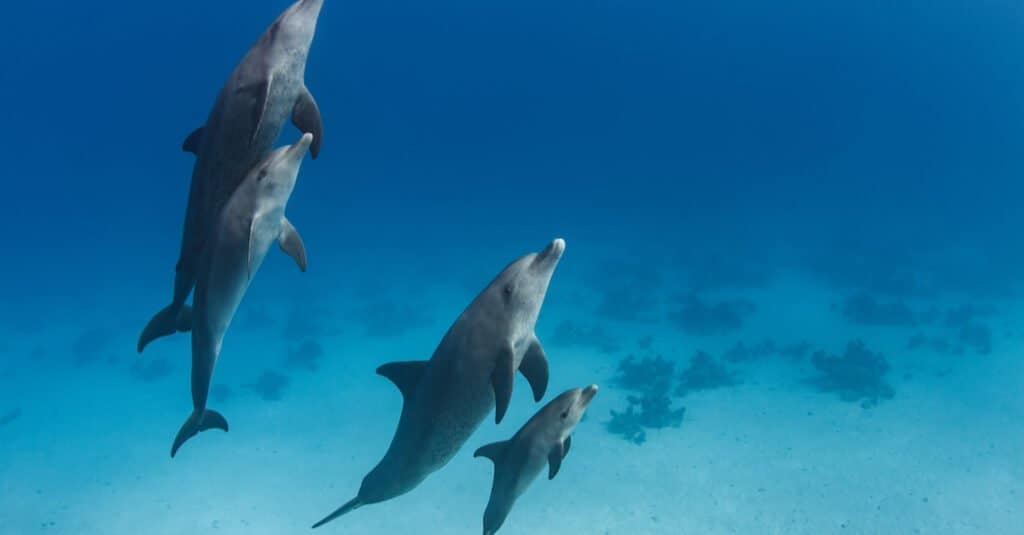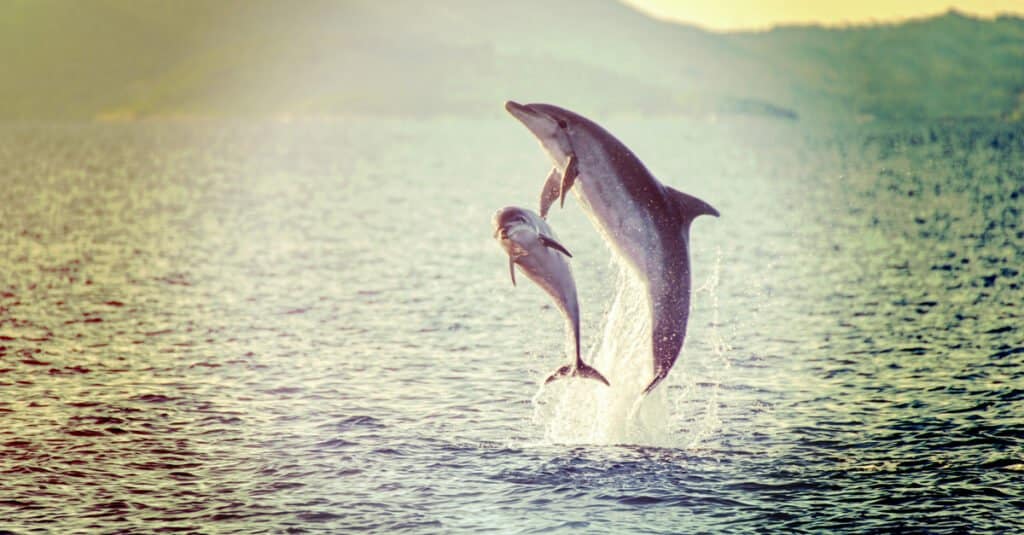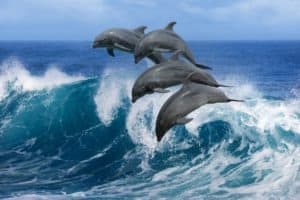Baby dolphin calves are some of the most adorable sea mammals in the world. You’ve probably heard about how highly intelligent they are, but did you know they use their tongues as straws or that they’re born with mustaches? Let’s dive into five amazing dolphin facts and look at some adorable dolphin calf pictures!
#1: Baby Dolphins Use Their Tongues as Straws

Newborn
dolphins
use their tongues as straws while nursing.
©Lynne Nicholson/Shutterstock.com
Imagine trying to take a swig of juice while you’re underwater. Pretty impossible, right? Baby dolphins are faced with a unique roadblock when it comes to nursing from their mothers: they’re underwater. Since breastmilk is a liquid, you might be wondering just how baby dolphins can drink their mother’s milk while remaining in the water.
The answer is astounding: they use their tongues as a straw. Dolphin calves roll their tongues up like a straw when it’s time to drink their mother’s milk. Dolphin calves don’t control how much they eat. Instead, their mothers do. Once a dolphin calf is latched onto its mother’s nipple, the female dolphin shoots milk directly into the baby dolphin’s mouth. This makes it possible for a full feeding to take just a few seconds.
Another thing that makes it easier for baby dolphins to drink milk underwater is the consistency of the breastmilk. It is about as thick as a milkshake, which makes it less difficult for baby dolphins to get their nutrition while swimming under the sea!
#2: One Dolphin Calf Blew Underwater Milk Rings to Imitate its Trainer

A dolphin calf and its mother come up for air.
©Christian Wittmann/Shutterstock.com
Baby dolphins are smart cookies! One six-month-old baby dolphin named Dolly learned how to copy its trainers smoke rings underwater. This tiny dolphin saw her trainer blow a cloud of smoke, so it swam back to its mother, got a mouthful of breastmilk, and swam back. She then spat the milk out in the water, creating a smoke-like cloud around her!
Dolly’s trainer stated that he didn’t work with her to do this trick at all. Instead, she made the connection that spitting out the milk underwater would look similar to smoke in the air. This incident just goes to show how incredibly intelligent baby dolphins are!
#3: Dolphins are Born with Mustaches

Dolphin calves are born with tiny hairs around their snouts.
©Willyam Bradberry/Shutterstock.com
Did you know baby dolphins are born with a mustache? It’s true, but the more astonishing thing about this mustache is what it does for the tiny sea animals. Since baby dolphins are born with less-than-perfect eyesight, they need a different way to locate their mothers during their first few days on the earth.
The tiny hairs are short and grow around the baby’s snout. After a few days, these hairs naturally shed since dolphin calves no longer need them.
#4: Baby Dolphins Can’t Breathe Underwater

Dolphin calves must come to the surface for oxygen.
©Tomas Picka/Shutterstock.com
Baby dolphins are marine animals, so you might assume that they can breathe underwater like other fish. You will probably be surprised to learn that dolphin calves are mammals! That means baby dolphins and their parents lack gills, which makes it impossible for them to breathe underwater. Instead, they must come to the surface to get air.
Because of this, baby dolphins are born tail-first. This ensures that they don’t drown before they can surface for their first breath of air. Dolphin calves can hold their breath underwater for up to 15 minutes since they can conserve the air in their lungs and only need to use a little at a time to keep oxygen flowing to their brains.
Baby dolphins also don’t breathe out of their mouths like other mammals. Instead, they take oxygen in from blowholes, which are on the tops of their heads. Each time a dolphin calf takes a breath, they fill about 80% to 90% of their lungs. When you compare that to the typical human breath that fills only 10% of lungs, it puts it into perspective just how miraculous baby dolphins are!
#5: Dolphin Calves Learn to Swim in the Mother’s Womb

Dolphin calves can swim from the moment they are born.
©marshalgonz/Shutterstock.com
When baby dolphins are born, they must immediately swim to the surface to take their first breath of air. But how do they know how to swim so soon? The answer is amazing: they learn to swim while they’re gestating in their mothers’ wombs!
Scientists say that baby dolphins have been observed swimming around inside the womb as early as 9 weeks gestation. Since dolphins have a gestation period that ranges anywhere from nine to twelve months, dolphin calves have plenty of time to get all the practice they need to learn how to swim!
The photo featured at the top of this post is © marshalgonz/Shutterstock.com
FAQs (Frequently Asked Questions)
How big are baby dolphins?
Newborn baby dolphin calves can weigh anywhere from 22 to 44 pounds and usually measure between 39 and 53 inches long.
What do baby dolphins eat?
Baby dolphin calves survive exclusively on their mother’s milk for the first six months to two years of life. After that, they eat crustaceans and fish.
What are baby dolphins called?
A single baby dolphin is called a calf. A group of them is called a pod.
Thank you for reading! Have some feedback for us? Contact the AZ Animals editorial team.






